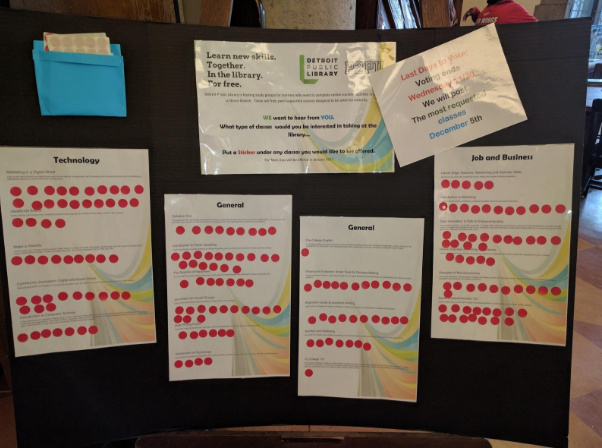Strategies
Hosting in-person learning communities can be hard work. Not only do you need a strong understanding of local interests and needs, but you need ways to broadcast your message that will both reach and resonate with your intended audience. In early 2019, we convened a community call with a dozen learning circle facilitators and documented some best practices for learning circle promotion.
Here are some strategies that you can considering adopting:
The Q Method
The Q-Method is participatory public bulletin, created using paper, tape and stickers, to document and display community interest on specific topics, online courses or ideas. It’s named after Qumisha Goss, who came up with the idea as a way to promote learning circles in at Detroit Public Library.

The most popular course with 20 votes was Marketing in a Digital World. There was a tie for second place – Introduction to Public Speaking and Social Entrepreneurship 101 both received 16 votes. Based on the results, Parkman Branch offered both the marketing and public speaking courses as learning circles.
What’s great about the Q-Method is that it both invites community contribution for deciding topics, and serves to promote the program. This concept has been re-used by learning circle facilitators around the world, and can also have application for other community feedback issues, such as strategic planning, programming decision-making, and understanding community satisfaction and engagement. You can download a template to create your own Q-Method board here.
Focus Groups
In Kenya, libraries run mini focus group as part of their learning circle training. They get a quick idea of what their local library patrons are interested in and their digital literacy skills which they can use for discussion as they continue their training workshop. Some libraries have offered a learning circle teaser or public orientation where they introduce the concept of learning circles through an informal meeting or large presentation and, through these meetings, they also receive feedback about what people are interested in learning. You can check out a sample of focus group questions here.
Partnerships
National, regional and local partners have a good understanding of the needs and interests of people who you might not yet know. They might also already host community groups meeting about certain topics, which can be a great starting point for starting a learning circle. Here are some examples of organizations that learning circle communities have successfully partnered with in the past:
- Employment and social services. Local social services have employment specialists who regularly support people who are looking to re-train or who are looking for work. Employment services might be able to refer their clients to your learning circle and suggest specific interests.
- Housing authorities: Public housing often has community space which support people to gain digital literacy skills. These community spaces might be able to host learning circles or guide people towards your learning circle on gaining digital skills.
- National issue-based non-profits: Many nonprofits are focused on supporting educational issues in key areas and are regularly looking for new audiences to work with. These organizations might have access to interested facilitators who might want to pair learning circles with their programs, access to interested learners, or might want to support your organization to use their free educational resources Examples of these organizations include organizations focus on digital literacy (e.g. National Technology Enterprise Network), writing (e.g. NaNoWriMo), and computer skills (e.g. Linux Professional Institute).